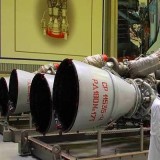B-1B Lancers Deployed to Guam a Strategic Reinforcement for Indo-Pacific

{loadposition bannertop}
{loadposition sidebarpub}
Four U.S. Air Force B-1B Lancer strategic bombers landed at Andersen Air Force Base on Guam on January 15, 2025, marking the start of the year’s first Bomber Task Force mission. These aircraft, from the 34th Expeditionary Bomb Squadron based at Ellsworth Air Force Base in South Dakota, play a pivotal role in U.S. efforts to strengthen alliances and deter threats in the Indo-Pacific region.
Follow Army Recognition on Google News at this link
the B-1 Lancer is a long-range, versatile strategic bomber that holds a central position in the U.S. Air Force’s arsenal (Picture source: US Air Force)
A key feature of this mission was an unprecedented trilateral flight conducted over airspace between Japan and South Korea. Two B-1Bs were escorted by two Mitsubishi F-2 fighters from Japan’s Air Self-Defense Force and two F-15K Slam Eagles from the South Korean Air Force. This operation underscores growing trilateral military cooperation, reflecting closer ties between these nations as they address security challenges in the South China Sea, the Taiwan Strait, and the Korean Peninsula.
Originally developed by Rockwell (now part of Boeing), the B-1 Lancer is a long-range, versatile strategic bomber that holds a central position in the U.S. Air Force’s arsenal. Its unique variable-geometry wing configuration enables the aircraft to adjust wing angles for optimal performance during various phases of flight. Powered by four General Electric F101-GE-102 turbofan engines, the B-1B can reach a top speed of 1,340 km/h and a range of 11,998 km with aerial refueling. Operated by a crew of four — a pilot, a co-pilot, and two systems operators — it is designed to execute complex, long-range missions.
The B-1B is distinguished by its significant payload capacity. Its three internal weapon bays and eight external hardpoints allow it to carry up to 75,000 pounds of ordnance, including conventional bombs such as Mk 82 and Mk 84, AGM-86B, and AGM-69 cruise missiles, as well as nuclear payloads like the B-61 or B-83 bombs. This adaptability makes it a valuable asset for a wide range of high-intensity missions.
To enhance survivability, the B-1B features advanced avionics and countermeasure systems. The AN/ALQ-161 electronic warfare suite enables radar jamming, while the APQ-164 multi-mode radar provides high-resolution terrain mapping, terrain-following capability, and weather detection. These systems, along with chaff and infrared decoy dispensers, ensure the bomber can penetrate contested airspace and avoid threats effectively.
The B-1 B entered service in 1986 as a nuclear-capable platform and was later adapted in the 1990s for conventional bombing missions. Since then, it has played a critical role in major operations, including Desert Fox in 1998 and campaigns in Afghanistan and Iraq. Its ability to adapt to evolving operational requirements has solidified its importance within U.S. strategic planning.
The current deployment to Guam also highlights the evolution of U.S. military presence strategies in the region. Since 2020, the Air Force has shifted from a continuous bomber presence on the island to a rotational model through Bomber Task Forces. This approach provides operational flexibility while maintaining a credible deterrent. With its strategic location just 1,600 miles from Taiwan and 1,800 miles from South Korea, Guam serves as a vital hub for projecting power in a region marked by increasing tensions.
These Bomber Task Force missions extend beyond deterrence. They also serve as a proving ground for crew endurance and readiness. With flight durations often exceeding 24 hours and sometimes approaching 30, such missions test operational capabilities and demonstrate the Air Force’s ability to sustain operations across diverse and distant environments.
In summary, the deployment of B-1B bombers to Guam is part of a broader strategy aimed at reinforcing alliances and addressing security challenges in the Indo-Pacific. More than a demonstration of military strength, this mission reflects a measured approach to projecting power, reassuring regional partners, and deterring potential adversaries. As the Task Force mission continues, it underscores the United States’ commitment to upholding stability and the international rules-based order in this strategically significant region.

{loadposition bannertop}
{loadposition sidebarpub}
Four U.S. Air Force B-1B Lancer strategic bombers landed at Andersen Air Force Base on Guam on January 15, 2025, marking the start of the year’s first Bomber Task Force mission. These aircraft, from the 34th Expeditionary Bomb Squadron based at Ellsworth Air Force Base in South Dakota, play a pivotal role in U.S. efforts to strengthen alliances and deter threats in the Indo-Pacific region.
the B-1 Lancer is a long-range, versatile strategic bomber that holds a central position in the U.S. Air Force’s arsenal (Picture source: US Air Force)
A key feature of this mission was an unprecedented trilateral flight conducted over airspace between Japan and South Korea. Two B-1Bs were escorted by two Mitsubishi F-2 fighters from Japan’s Air Self-Defense Force and two F-15K Slam Eagles from the South Korean Air Force. This operation underscores growing trilateral military cooperation, reflecting closer ties between these nations as they address security challenges in the South China Sea, the Taiwan Strait, and the Korean Peninsula.
Originally developed by Rockwell (now part of Boeing), the B-1 Lancer is a long-range, versatile strategic bomber that holds a central position in the U.S. Air Force’s arsenal. Its unique variable-geometry wing configuration enables the aircraft to adjust wing angles for optimal performance during various phases of flight. Powered by four General Electric F101-GE-102 turbofan engines, the B-1B can reach a top speed of 1,340 km/h and a range of 11,998 km with aerial refueling. Operated by a crew of four — a pilot, a co-pilot, and two systems operators — it is designed to execute complex, long-range missions.
The B-1B is distinguished by its significant payload capacity. Its three internal weapon bays and eight external hardpoints allow it to carry up to 75,000 pounds of ordnance, including conventional bombs such as Mk 82 and Mk 84, AGM-86B, and AGM-69 cruise missiles, as well as nuclear payloads like the B-61 or B-83 bombs. This adaptability makes it a valuable asset for a wide range of high-intensity missions.
To enhance survivability, the B-1B features advanced avionics and countermeasure systems. The AN/ALQ-161 electronic warfare suite enables radar jamming, while the APQ-164 multi-mode radar provides high-resolution terrain mapping, terrain-following capability, and weather detection. These systems, along with chaff and infrared decoy dispensers, ensure the bomber can penetrate contested airspace and avoid threats effectively.
The B-1 B entered service in 1986 as a nuclear-capable platform and was later adapted in the 1990s for conventional bombing missions. Since then, it has played a critical role in major operations, including Desert Fox in 1998 and campaigns in Afghanistan and Iraq. Its ability to adapt to evolving operational requirements has solidified its importance within U.S. strategic planning.
The current deployment to Guam also highlights the evolution of U.S. military presence strategies in the region. Since 2020, the Air Force has shifted from a continuous bomber presence on the island to a rotational model through Bomber Task Forces. This approach provides operational flexibility while maintaining a credible deterrent. With its strategic location just 1,600 miles from Taiwan and 1,800 miles from South Korea, Guam serves as a vital hub for projecting power in a region marked by increasing tensions.
These Bomber Task Force missions extend beyond deterrence. They also serve as a proving ground for crew endurance and readiness. With flight durations often exceeding 24 hours and sometimes approaching 30, such missions test operational capabilities and demonstrate the Air Force’s ability to sustain operations across diverse and distant environments.
In summary, the deployment of B-1B bombers to Guam is part of a broader strategy aimed at reinforcing alliances and addressing security challenges in the Indo-Pacific. More than a demonstration of military strength, this mission reflects a measured approach to projecting power, reassuring regional partners, and deterring potential adversaries. As the Task Force mission continues, it underscores the United States’ commitment to upholding stability and the international rules-based order in this strategically significant region.





